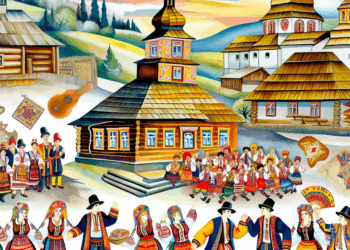Introduction
Bukovyna is a historical region located in north-western Ukraine and southern Romania. During the 20th century, the region has undergone a number of significant territorial changes and annexations, which have had an impact on its population, culture and economy. This article examines the key moments influencing the fate of Bukovina, from its incorporation into the Austrian Empire in 1775 to its present-day borders.
1. Incorporation into the Austrian Empire (1775)
In 1775, in the context of the expansion of Habsburg influence in Eastern Europe, Bukovina was annexed to the Austrian Empire, becoming part of the Duchy of Bukovina. This event occurred after the partitions of the Polish-Lithuanian Commonwealth, which gave Austria, Russia and Prussia significant territories. Austrian rule brought a number of administrative reforms to the region and developed infrastructure, which favoured economic growth.
By the mid-19th century, Bukovina had become a multicultural region populated by Ukrainians, Romanians, Germans, Polish and Jewish communities. The Habsburg regime promoted various social and cultural changes, which would affect the identity and political sentiments of the population in the future.
2. World War I and the transition to Romania (1918)
With the outbreak of the First World War in 1914, the status of Bukovina changed again. In 1918, following the collapse of the Austrian Empire, Bukovina declared autonomy, but was soon annexed to Romania. This unification took place against a background of comprehensive political instability caused by revolutionary movements in many parts of Europe.
After the war, the Treaty of Trianon was signed in 1920, which secured Romania’s control over Bukovina. The Romanian government sought to integrate the region into its cultural and political system, but this provoked resistance from the local Ukrainian population, who sought greater autonomy and preservation of their cultural traditions.
3. Soviet invasion and annexation (1940)
With the outbreak of World War II, the geopolitical situation changed dramatically again. In 1940, against the background of the signing of the Molotov-Ribbentrop Pact, the Soviet Union laid claim to the northern part of Romania – including Bukovina. As a result, in June 1940, Romania agreed to cede Northern Bukovina to the USSR.
The Soviet authorities carried out land reform, nationalising much of the agricultural and industrial economy. A Soviet regime was established in the region, which caused discontent among the local population. The events of the second half of the 1940s, including repressions, clashes and resettlements, strongly affected the demographic and cultural structure of Bukovina.
4. Victory over fascism and the post-war period
After the end of World War II, Bukovyna remained part of the USSR, and in 1947, according to the Paris Peace Treaty, it was officially assigned to the Ukrainian SSR. This phase was marked by a sharp deterioration of the economic situation and a change in the ethnic composition of the population, as many Romanians and Germans were forced to leave the region.
The Soviet authorities continued their policy of Russification, which also affected the local culture and language. At this time, Bukovina was undergoing processes aimed at strengthening industry, but the rural population was still experiencing difficulties.
5. Ukraine’s independence and modern borders
After the collapse of the Soviet Union in 1991, Bukovyna became part of independent Ukraine. This change of power marked a new period for the region, with the restoration of the cultural and linguistic rights of various national minorities.
The modern borders of Bukovyna run along the length of the state border between Ukraine and Romania, separating one of the most culturally diverse regions in Europe. It is important to note that the majority of Romanians and Ukrainians living in Bukovyna strive to strengthen mutual understanding and co-operation, despite historical contradictions.
Conclusion
The history of Bukovina in the 20th century is an illustration of the complex and often contradictory geopolitical processes that shaped its territorial boundaries and ethnic composition. This land has witnessed numerous changes: from annexation to the Austrian Empire, to the loss of autonomy under the Soviet Union, and then to the independence of Ukraine. Preserving cultural heritage and supporting dialogue between different ethnic groups remain important challenges for the people of the region today.








